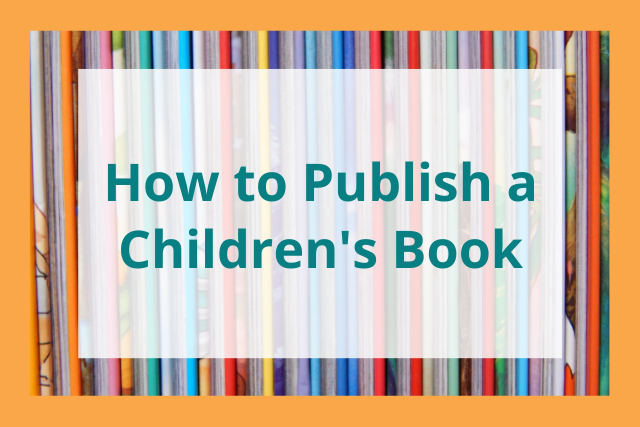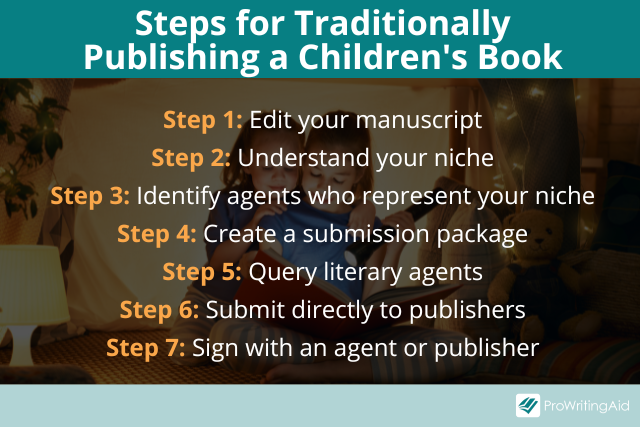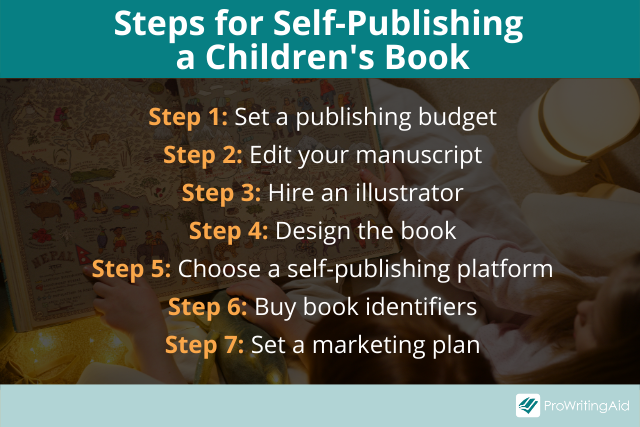
So, you’ve finished writing your children’s book, and you’re ready to send it out into the world.
First of all, congratulations! Writing a whole book is no easy feat. Don’t forget to stop and celebrate how far you’ve come.
Once you’re done celebrating, it’s time to figure out what your next steps are. How exactly do you publish your book?
In this article, we’ll give you a step by step guide for how to publish a children’s book and help you figure out which publishing path is right for you.
Types of Publishing for Children’s Books
Just like with all other kinds of fiction, there are three possible paths for publishing a children’s book: traditional publishing, indie publishing, and self-publishing.
Let’s take a closer look at each of these options.

Option 1: Traditional Publishing
The traditional publishing path involves signing with a literary agent, and then submitting your book to one of the major publishing houses.
If a publishing house loves your book, they’ll sign a contract with you. They’ll oversee all the major steps of the publishing process, such as hiring a children’s book illustrator, formatting your manuscript, and distributing your book to major bookstores.
In addition, they’ll pay you an advance against royalties before your book even gets published, which typically ranges from a few thousand dollars to a six-figure deal.
Option 2: Indie Publishing
Independent or “indie” publishing is an increasingly popular publishing path.
Independent publishers are smaller presses that accept unsolicited manuscripts. In other words, they don’t require you to sign with a literary agent before you submit your book to them.
Indie publishers vary widely in terms of how much they pay you and how much control they give you. Some indie publishers might let you choose your own illustrators, whilst others will take care of that process.
Option 3: Self-Publishing
When you self-publish a book, you oversee the entire publication process on your own. You’re responsible for deciding who edits the manuscript, who makes the illustrations, how the book gets marketed, and all the other steps involved in publication.
Self-published authors wear many hats. You’ll need to act as a businessperson and a marketing expert in addition to being a writer in order to achieve success.
The good news is that you can skip all the gatekeepers. If your book doesn’t fit what agents and traditional publishers are currently looking for, you can still self-publish a great children’s story on your own.
Which Path Should You Choose?
There’s no one-size-fits-all answer for which publishing path you should take. Do some research on all three publication options and decide which one suits you best.
One factor to consider is creative control. If you want to choose your own illustrator or even use your own illustrations in your children’s book, self-publishing is much more likely to give you those options.
Another factor is your budget. Selling your children’s book to traditional publishers will cost you nothing, while self-publishing successfully will require an investment of hundreds or even thousands of dollars.
How to Know You’re Ready to Publish Your Children’s Book
It’s important not to send your book out into the world before it’s ready. If you do, you run the risk of getting poor reviews and disappointed readers.
So, how do you figure out when your book is truly ready?
You can start with a simple self-assessment. Does your book have a clear beginning, middle, and end? Are the characters interesting and engaging? Are there any issues with the manuscript that you still want to fix?
Remember that you don’t have to make this judgment call on your own.
If you know other children’s book writers, you can offer to read each other’s manuscripts and swap feedback. Additionally, you can find great communities of critique partners on online forums and social media.
You can even reach out to children you know within your book’s target age range—with their parents’ permission, of course—to tell them about your story and ask if they’d be willing to read it and share their thoughts with you.
If many of the people who have read your book are still pointing out major issues you haven’t addressed, you should give yourself time to fix those issues before you start thinking about publication. You’ll be doing yourself—and your readers—a favor.
On the other hand, if the consensus is that your manuscript is ready, it might be time to take the leap!
How to Get Your Children’s Book Traditionally Published in 7 Steps
If you want to get your children’s book published by a publishing house, you have to know how the publishing industry works.
Here are the seven steps to follow to get traditionally published.
- Step 1: Edit your manuscript
- Step 2: Understand your niche in the market
- Step 3: Identify agents who represent your niche
- Step 4: Create a submission package
- Step 5: Query literary agents
- Step 6: Submit directly to publishers
- Step 7: Sign with an agent or publisher

Step 1: Edit Your Manuscript
It’s important to make sure your manuscript is as polished as possible before you submit it to industry professionals.
A single typo or grammatical error might not be a dealbreaker, but if your book is littered with repeated errors, you might get rejected even with a great story.
You should complete both developmental editing and copyediting before you seek publication. Developmental editing focuses on big-picture issues like character, plot, and theme, while copyediting focuses on your line-level prose.
Step 2: Understand Your Niche in the Market
There are many different types of children’s books. Understanding where your book fits in the current children’s literature market is crucial for getting published.
Start by figuring out which age category your book belongs in and ensuring you’re within your target word count range:
- Picture Books: under 5 years old; 500–1,000 words
- Early Readers: 5–8 years old; 1,000–5,000 words
- Chapter Books: 7–9 years old; 5,000–20,000 words
- Middle Grade Novels (MG): 9–12 years old; 15,000–50,000 words
- Young Adult Novels (YA): 12–18 years old; 50,000–100,000 words
In addition to knowing your age category, you also need to know your genre and subgenre. Are you writing fantasy, adventure, or mystery? Does your book include any tropes that are popular in the children’s book market?
You can go to your local bookstore and look for the place on the shelf where your book would sit. Figuring out which books are popular in your category can help you decide how to pitch your book.
Step 3: Identify Agents Who Represent Your Niche
Most traditional publishing houses don’t accept unsolicited manuscripts. That means you’ll need a literary agent to submit your manuscript for you.
Every literary agent has their own specialties. A literary agent who represents fantasy chapter books might not be looking for mystery young adult novels, and vice versa.
There are many resources online that can help you search for literary agents. Here are a few to get you started:
- Manuscript Wishlist: a website where agents post their “wish lists” of all the genres and tropes they’re looking for
- QueryTracker: a site where you can see how many authors are submitting to each literary agent and how fast their response times are
- Publishers Marketplace: a site where you can see book deal announcements, including the agents who negotiated those deals
Compile a list of at least 20 literary agents who seem like a good fit for your book. Querying can be a long process, so it’s good to give yourself a lot of options.
Step 4: Create a Submission Package
Once you have a list of agents to submit to, it’s time to create your submission package.
To begin with, you’ll need a query letter, which is a cover letter that briefly pitches your book. Check out our article on how to write a compelling query.
You should also prepare a sample of your work, formatted to match each agent’s submission guidelines. If you’re writing a picture book, most agents will ask for the entire manuscript. If you’re writing a middle grade or young adult novel, most agents will only ask for the first few pages or first few chapters.
Step 5: Query Literary Agents
Now it’s time to start sending out your submission package!
Most agents don’t ask for exclusive submissions, meaning you can and should submit your manuscript to multiple agents at the same time. That way, you aren’t left waiting for months at a time for a single person to get back to you.
Try querying in batches of three to five agents. This method gives you the flexibility to revise your submission package if you get feedback.
Step 6: Submit Directly to Publishers
While you’re querying, you can also submit your manuscript directly to publishers.
You can start by looking at independent children’s book publishers that publish books in your genre.
Before you submit to an indie publisher, you should check their website to make sure they’re a reputable company, that they accept unsolicited submissions, and that they’re a good fit for your book.
Some traditional publishers also have imprints, which are trade names for specific groups of books, that accept unsolicited manuscripts. For example, Penguin Random House has an imprint called Dial Books for Young Readers which accepts unsolicited manuscripts.
Step 7: Sign with an Agent or Publisher
Once you have an offer, congratulations! You’ve made it past the hardest step toward publishing a book. Make sure that you understand the contract you are signing. If in doubt, consult a legal expert or organization such as the Society of Authors.
There are a lot more steps you’ll need to take before your book reaches readers, such as editing and marketing, but your agent or publisher will guide you through that process. At this point, you’re off to the races!
How to Self-Publish Your Children’s Book in 7 Steps
If you’ve decided self-publishing is a better path for you, your journey will look very different. Instead of creating a submission package, you’ll be focusing on preparing your self-published book for readers right from the get-go.
Here are the seven steps to follow to self-publish your children’s book:
- Step 1: Set a publishing budget
- Step 2: Edit your manuscript
- Step 3: Hire an illustrator
- Step 4: Design the book
- Step 5: Choose a self-publishing platform
- Step 6: Buy book identifiers
- Step 7: Set a marketing plan

Step 1: Set a Publishing Budget
Self-publishing can be expensive. If you don’t set a budget in advance to help you prioritize where your money goes, you might find yourself racking up expenses you can’t afford.
Here are some common categories of expenses to consider:
- Editorial services (e.g. developmental edits, copy edits, proofreading)
- Illustrations
- Book design and formatting
- Book identifiers (e.g. ISBN, CIP data)
- Marketing (e.g. author website, online ads)
Each of the above steps can cost hundreds of dollars, if not more. A professional illustrator will charge thousands, or even tens of thousands, for a full children's picture book.
It’s important to determine how much you’ll be able to invest in each step, so you can publish the best possible version of your book.
Step 2: Edit Your Manuscript
Once you know your budget, it’s time to polish your manuscript to perfection!
If you’re publishing traditionally, your publishing house will edit your book for you, but if you’re self-publishing, you’re the last line of defense before your book reaches readers.
You can consider hiring a developmental editor and a copyeditor if you have room for those services in your budget.
Whether or not you hire professionals, you should also run your book through a good grammar checker. ProWritingAid can help you improve sentence flow, replace clichés, and polish your writing to match industry standards.
Step 3: Hire a Children’s Book Illustrator
Many children’s books require illustrations, especially picture books and books for early readers.
Start by choosing the art style you want for your story. You might want pictures that are fun and bright, or you might want pictures that are muted and soothing.
Make a list of children’s book illustrators whose styles match your vision. You can find illustrators through websites like Children’s Illustrators and Hire an Illustrator, or even social media platforms like Instagram and Facebook.
Start by commissioning sample illustrations, like a character sketch or a full page, to make sure their work matches your vision. If you like the samples, you can hire them to illustrate the entire book.
Step 4: Design the Book
Book design includes page layout, font choice, book trim size, the front and back cover design, and more. All these steps are crucial if you’re writing a picture book, since picture books rely more heavily on visuals than books for older readers.
You can hire a book designer to make sure your book is ready for printing. Alternatively, there are resources online that can help you design and format your book on your own.
Step 5: Buy Book Identifiers
You’ll need unique book identifiers if you want to sell your book in bookstores, libraries, and most other retailers.
An ISBN is a thirteen-digit universal ID for your book, which you’ll often see at the top of a barcode. You’ll need to buy a separate ISBN for each edition of your book, such as paperback, eBook, and hardcover.
You can also consider investing in P-CIP data, a PCN number, and other book identifiers.
Step 6: Choose a Self-Publishing Platform
There are many popular platforms you can use to self-publish your book.
Some of the most popular platforms include Amazon KDP, IngramSpark, Barnes & Noble Press, and Lulu. Most print on demand, meaning they’ll print new copies when readers buy them.
Alternatively, you can use an offset book printer, which often gives you higher quality results, especially with picture books. The downside is that they usually require you to pay for and store at least 500 books upfront.
Step 7: Set a Marketing Plan
Now you have everything you need to publish your book. It’s time to make sure readers know it exists!
You can plan a launch event, such as a book signing at your local bookstore or a party in your neighborhood.
You can also team up with other children’s book authors to boost each other’s work and write each other blurbs and reviews.
And that’s it—make your first sale, and you’re officially a professional author!
FAQs for How to Publish a Children’s Book
Publishing a children’s book is a confusing journey, and a lot of writers have questions about what to expect. Here are our answers to some common questions.
How Much Does It Cost to Publish a Children’s Book?
The cost of publication depends on which publishing path you choose.
If you self-publish a book, you’ll need to invest a lot of money upfront before you see any royalties. That’s because you’ll probably want to hire a developmental editor, a copyeditor, a cover designer, and countless other professionals to work on your book—and all of that money has to come out of your own pocket.
If you choose traditional or indie publishing, on the other hand, you can absolutely publish your children’s book for free. That’s because money should always flow to the author.
Your agent will take a commission on what you make, but that won’t happen until you make money on the book. Similarly, publishing houses should pay you—you will never have to pay them.
How Much Can You Make from Children’s Books?
How much you earn from your children’s book depends on how many copies you sell. A good target for a debut author is around 1,000 copies. If you sell 1,000 copies and make $1 on each, you can expect to make $1,000 in royalties.
If you work with a publishing house, they’ll usually pay you an advance against royalties. Advances can range from $0 to six-figure sums, depending on how well they think your book will sell.
How Difficult Is It to Get a Children’s Book Published?
It’s certainly not easy to get a book traditionally published. Fewer than 1% of all aspiring authors manage to get a traditional publishing deal.
That means that for every author who signs a successful book deal, there are 99 more who didn’t get as lucky.
The good news is that the authors who succeed are those who persevere. You’ll gain new skills and experience with every children’s book you write.
Many famous children’s book authors never sold their first book, but achieved commercial success with their second, third, or even tenth manuscript.
And don’t forget that self-publishing is always an option, and often a successful one.
Can You Publish a Children’s Book for Free?
As we mentioned earlier, you can absolutely publish children’s books for free if you choose the traditional publishing route. Money always flows to the author, never the other way around.
Spending money is never required in order to traditionally publish a book, but it can be a good idea if you have the money to spare.
For example, hiring a professional editor to look over your story can help you take it to the next level, especially if you know your book has issues that you don’t know how to fix on your own. Hiring an editor on your own can give you a higher chance of being accepted into traditional publishing.
Good luck, and happy writing!

